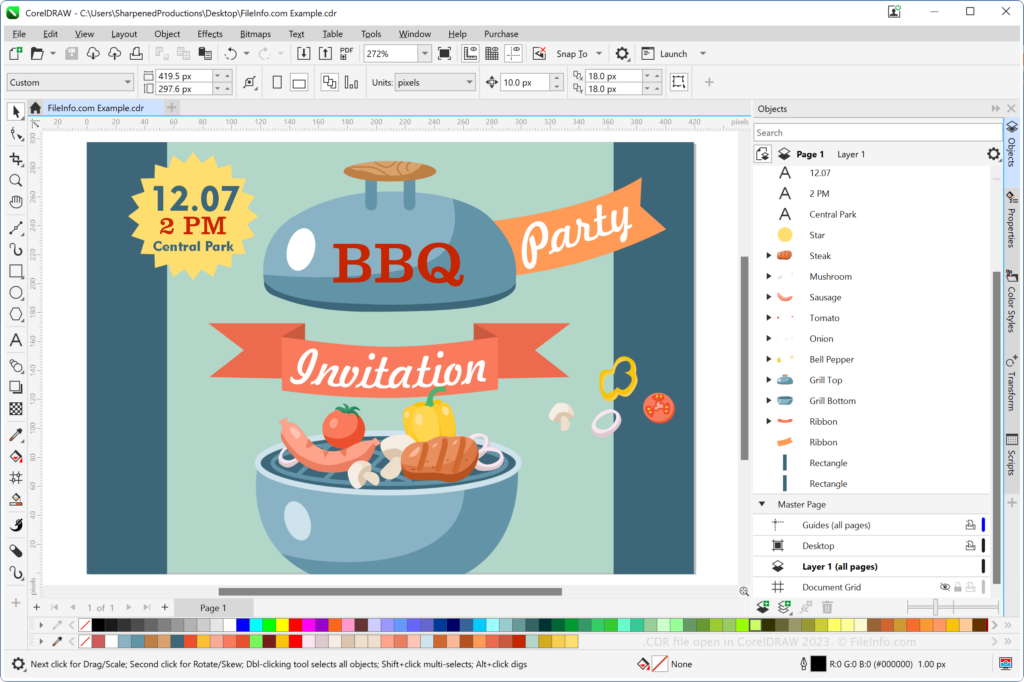Navigating the Design Ecosystem: A Comprehensive Guide to Supported File Formats in CorelDRAW

Introduction:
CorelDRAW, a stalwart in the realm of vector graphics editing, stands as a versatile powerhouse that accommodates a wide array of file formats, ensuring seamless integration with diverse design workflows. This comprehensive guide unravels the intricacies of supported file formats in CorelDRAW, exploring the expansive landscape of compatibility, importing and exporting options, and the significance of choosing the right format for your design projects.
I. The Foundation of Versatility:
- Vector Graphics and CorelDRAW:
- CorelDRAW’s strength lies in its ability to work with vector graphics, offering precision, scalability, and exceptional quality in design elements.
- Vector graphics enable designers to create illustrations, logos, and intricate artworks with clarity at any size.
- CorelDRAW as a Design Hub:
- As a central hub for design, CorelDRAW accommodates a wide spectrum of file formats, allowing designers to seamlessly integrate various elements into their projects.
- This versatility makes CorelDRAW a go-to platform for creative professionals in diverse industries.
II. Importing Supported File Formats:
- Common Image Formats:
- CorelDRAW supports common raster image formats such as JPEG, PNG, BMP, and GIF.
- Importing these formats allows designers to integrate photographs and other bitmap images seamlessly into their vector-based designs.
- Vector Graphic Formats:
- CorelDRAW excels in handling vector graphics formats, including SVG (Scalable Vector Graphics), AI (Adobe Illustrator), and CDR (CorelDRAW’s native format).
- The support for these formats ensures smooth collaboration with other design software and the flexibility to work with industry-standard files.
- Text and Font Formats:
- Support for text and font formats such as TTF (TrueType Font) and OTF (OpenType Font) enables designers to maintain consistent typography across projects.
- CorelDRAW’s compatibility with font formats ensures that text elements are faithfully represented in the design.
- PDF (Portable Document Format):
- PDF is a widely used format for document sharing, and CorelDRAW’s robust support ensures seamless import of PDF files.
- Importing PDFs into CorelDRAW allows designers to collaborate on projects or repurpose existing designs for further refinement.
- 3D Model Formats:
- CorelDRAW supports 3D model formats like 3DS and C4D, expanding its capabilities beyond traditional 2D design.
- Integrating 3D models into designs opens up new possibilities for creating dynamic and visually engaging graphics.
III. Exporting Supported File Formats:
- PDF Export Options:
- CorelDRAW offers extensive options for exporting designs to PDF, providing flexibility for different output requirements.
- PDF export settings include options for print, web, and digital distribution, catering to a variety of design applications.
- Exporting to Bitmap Formats:
- CorelDRAW allows designers to export their vector designs to common bitmap formats like JPEG, PNG, and TIFF.
- Exporting to bitmap formats is essential for web graphics, image sharing, and compatibility with non-vector-based platforms.
- Exporting to Vector Formats:
- CorelDRAW’s native format (CDR) supports all design elements, making it the ideal format for preserving the integrity of complex designs.
- Additionally, exporting to AI (Adobe Illustrator) format ensures compatibility with industry-standard vector graphics software.
- SVG Export for Web Compatibility:
- CorelDRAW’s support for SVG (Scalable Vector Graphics) export is crucial for web designers and developers.
- Exporting to SVG ensures that vector graphics maintain their scalability and quality when incorporated into web projects.
IV. Importance of Choosing the Right Format:
- Purpose and Intended Use:
- The choice of file format depends on the intended use of the design.
- For print, designers may opt for high-resolution formats, while web designers prioritize formats that balance quality with file size.
- Collaborative Workflows:
- When collaborating with others, understanding the preferred file formats of team members or clients is crucial.
- Choosing compatible formats ensures a seamless exchange of design assets and promotes efficient collaboration.
V. Troubleshooting and Tips:
- File Compression:
- Consider the impact of file compression on image quality when exporting to bitmap formats.
- Balancing file size with image quality is essential for achieving optimal results.
- Preserving Editability:
- When exporting to non-native formats, be mindful of preserving editability.
- Formats like SVG and AI allow for future edits and modifications, preserving the flexibility of the design.
VI. Continuous Learning and Adaptation:
- Staying Informed:
- The world of design is dynamic, with evolving standards and emerging formats.
- Designers should stay informed about updates, new formats, and best practices to adapt their workflows accordingly.
- Exploring Advanced Features:
- CorelDRAW offers advanced features for handling specific file formats.
- Exploring these features enhances designers’ proficiency and allows them to leverage the full capabilities of the software.
VII. Conclusion:
In conclusion, CorelDRAW’s comprehensive support for a diverse range of file formats positions it as a cornerstone in the creative design process. Designers can seamlessly import and export content, ensuring compatibility with various platforms, software, and collaborative workflows. By understanding the nuances of supported file formats, designers unlock the full potential of CorelDRAW, turning their creative visions into versatile and impactful designs across different mediums and applications. As design technologies continue to evolve, CorelDRAW remains a reliable ally, providing designers with the tools and flexibility needed to navigate the dynamic landscape of visual communication.




